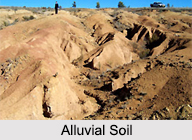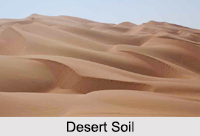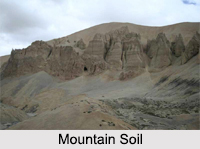 Soil can be defined as a layer of decaying organic matter and broken rock particles on the earth surface, which is necessary for plant growth. Soils are of different types and each of them differs in texture and nature. Indian Soil is one of the most wide-ranging components in the geography of India. The inhabitants of India largely count on the soil of the country for their survival. Several powers of nature like running water, wind and alteration of temperature, add to the development of Indian Soil. Organic and chemical alterations taking place within the soil layer are very essential. Given below are different soil types of India.
Soil can be defined as a layer of decaying organic matter and broken rock particles on the earth surface, which is necessary for plant growth. Soils are of different types and each of them differs in texture and nature. Indian Soil is one of the most wide-ranging components in the geography of India. The inhabitants of India largely count on the soil of the country for their survival. Several powers of nature like running water, wind and alteration of temperature, add to the development of Indian Soil. Organic and chemical alterations taking place within the soil layer are very essential. Given below are different soil types of India.
Types of Soils in India
Indian Soil is mainly divided into 8 major types. These Indian soil types are Alluvial Soil, Red Soil, Regur Soil, Laterite and Lateritic Soils, Arid and Desert Soils, Forest and Mountain Soils, Peaty and Marshy Soils and Saline and Alkaline Soils.
Alluvial Soil
Alluvial Soil is formed by accumulated sediments transferred by the rivers and rapids, thus it is amongst the most fertile soils. This soil generally lacks humus and nitrogen and is loaded with potassium. It forms around the lower courses of most rivers and particularly all over the Indo-Gangetic Plains. This soil covers an area of about 15 lakh sq kms in India and mainly contributes in the development of agriculture.
Red Soil
 Red Soil lacks nitrogenous material, phosphoric acid and organic matter and is rich in iron. It is formed by the breakdown of igneous rocks and metamorphic rocks. It is mainly seen in the district of Periyar and Salem in the state of Tamil Nadu. In India, red soil is also found in several other regions including Madhya Pradesh, Southern Karnataka, Maharashtra, Eastern Rajasthan, West Bengal and other states of north-east India.
Red Soil lacks nitrogenous material, phosphoric acid and organic matter and is rich in iron. It is formed by the breakdown of igneous rocks and metamorphic rocks. It is mainly seen in the district of Periyar and Salem in the state of Tamil Nadu. In India, red soil is also found in several other regions including Madhya Pradesh, Southern Karnataka, Maharashtra, Eastern Rajasthan, West Bengal and other states of north-east India.
Regur Soil
Regur Soil is black in color and is also known as Black Soil. Since it is perfect for growing cotton, it is called Black Cotton Soil. This type of soil has been found in some parts of Gujarat and Tamil Nadu. Apart from cotton, the black soil is widely used for producing crops like wheat, jowar, linseed, virginia tobacco and castor.
Laterite and Lateritic Soils
Characteristically, Laterite and Lateritic Soils can easily be cut with a spade but harden like iron when exposed to air. They are widely distributed in India and cover an area of about 2.48 lakh sq kms. They are mainly found on the summits of Western Ghats (at 1000 to 1500 m above mean sea level), Eastern Ghats, Rajamahal Hills, Vindhyas, Satpuras and Malwa Plateau. Typical laterite soils generally lack fertility and are not significantly utilized for crop production.
Arid and Desert Soils
 Desert Soils are basically of sandy texture and are brown, light brown or reddish in color. Some of these soils contain high percentages of soluble salts. They are alkaline with varying degree of calcium carbonate and are poor in organic matter. Due to the arid conditions, leaching of soil is almost absent in the desert soils and thus evaporation is quite rapid. Desert conditions prevail in a large part of the arid and semi-arid region in Rajasthan and adjoining areas of Punjab and Haryana lying between the Indus and the Aravalis.
Desert Soils are basically of sandy texture and are brown, light brown or reddish in color. Some of these soils contain high percentages of soluble salts. They are alkaline with varying degree of calcium carbonate and are poor in organic matter. Due to the arid conditions, leaching of soil is almost absent in the desert soils and thus evaporation is quite rapid. Desert conditions prevail in a large part of the arid and semi-arid region in Rajasthan and adjoining areas of Punjab and Haryana lying between the Indus and the Aravalis.
Forest and Mountain Soils
Creation of Forest and Mountain Soils is dependent upon the deposition of organic matter derived from forest growth. These soils are heterogeneous in nature and their character changes with parent rocks, ground-configuration and climate. These soils are mainly found on the hill slopes covered with forests. These soils are spread over an area of about 2.85 lakh sq kms. Forest Soils can be used for plantations of tea, coffee, spices, etc.
Peaty and Marshy Soils
Peaty Soils are black, heavy and highly acidic. They contain considerable amount of soluble salts and 10 to 40 percent of organic matter. The presence of these soils has been traced in humid regions as a result of the accumulation of large amounts of organic matter in the soils. Soils of this group are found in Kottayam and Alappuzha districts of Kerala. Most of the peaty soils are used for paddy cultivation. Marshy Soil with a high proportion of vegetable matter has been found in the coastal areas of Odisha and Tamil Nadu, Sunderbans of West Bengal, etc.
Saline and Alkaline Soils
Saline and Alkaline Soils are liable to saline and alkaline efflorescence. They are found in Andhra Pradesh and Karnataka.



















